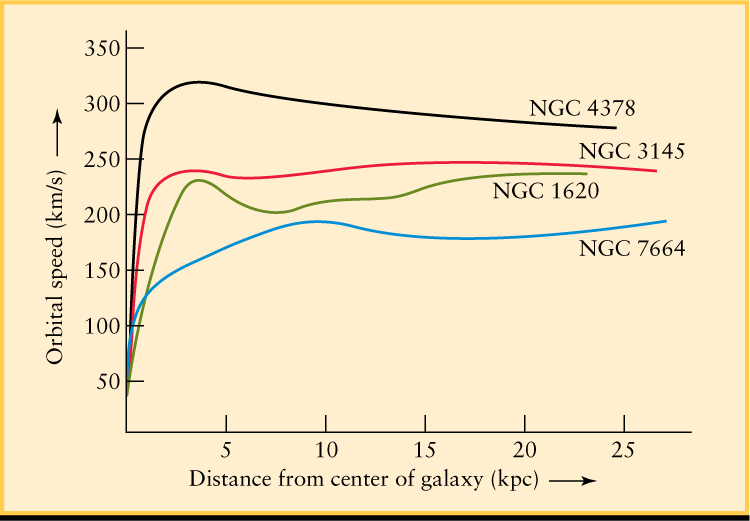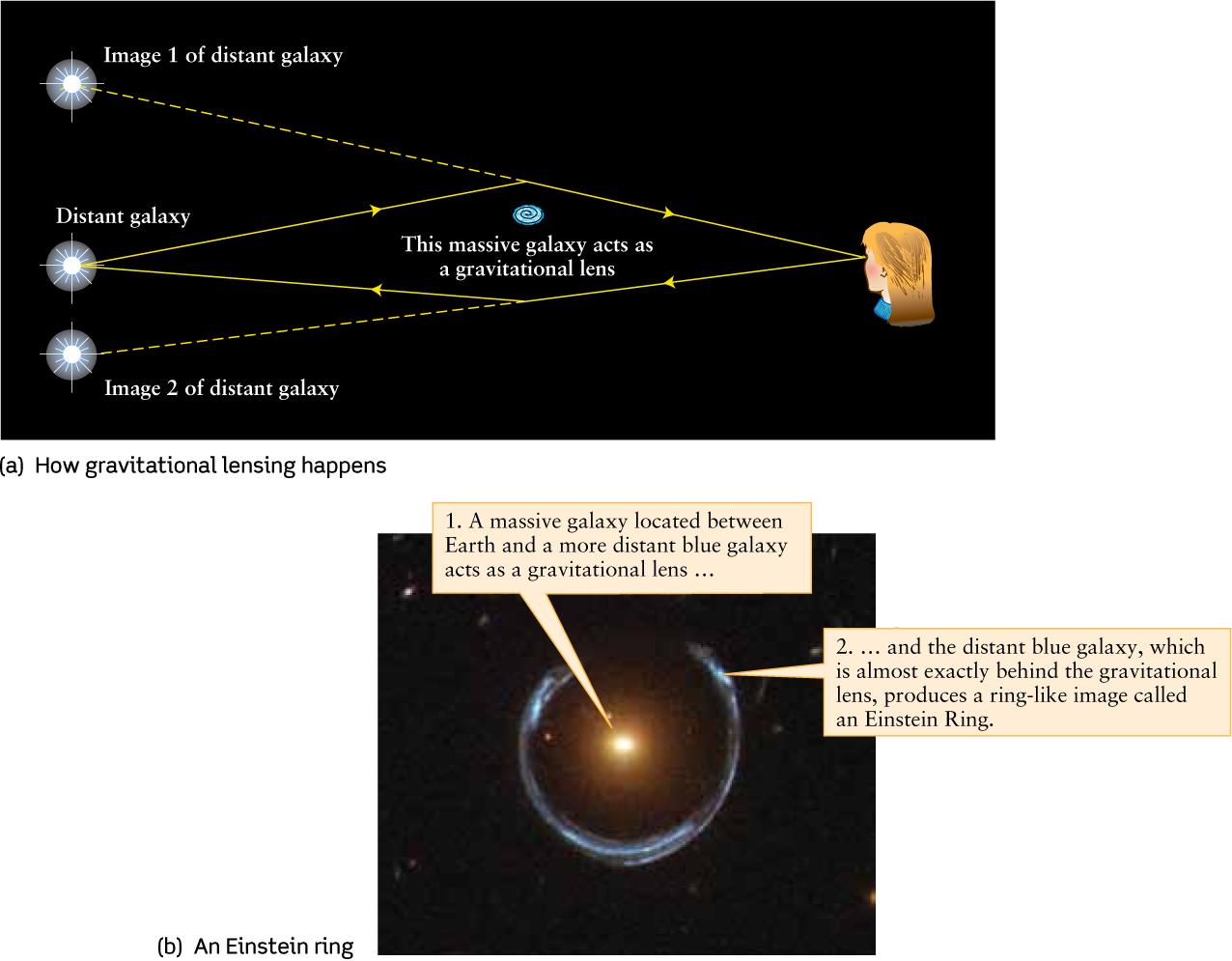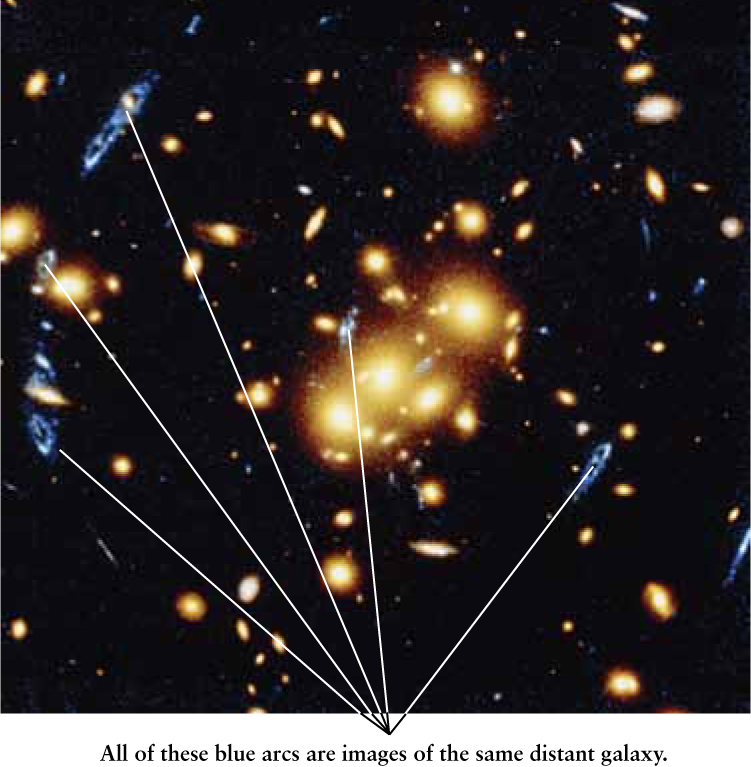23-8 Most of the matter in the universe is mysterious dark matter
Galaxies in a cluster typically move at large speeds and must be held in the cluster by gravity. In other words, there must be enough matter in the cluster to prevent the galaxies from drifting away. Nevertheless, careful examination of a rich cluster, like the Coma cluster shown in Figure 23-21, reveals that the mass of the visually luminous matter (principally the stars in the galaxies) is not at all sufficient to bind the cluster gravitationally. The observed line-of-sight speeds of the galaxies, measured by Doppler shifts, are so large that the cluster should have broken apart long ago. Considerably more mass than is visible is needed to keep the galaxies bound in orbit about the center of the cluster.
We encountered a similar situation in studying our own Milky Way Galaxy in Section 22-4: The total mass of our Galaxy is more than the amount of visible mass. As for our Galaxy, we conclude that clusters of galaxies must contain significant amounts of nonluminous dark matter. If this dark matter were not there, the galaxies would have long ago dispersed in random directions and the cluster would no longer exist today. Analyses demonstrate that the total mass needed to bind a typical rich cluster is about 10 times greater than the mass of material that shows up on visible-light images.
The Dark-Matter Problem and Rotation Curves
Vast assemblages of dark matter reveal their presence by bending passing rays of light
As for our Galaxy, the problem is to determine what form the invisible mass takes. A resolution to this dark-matter problem, which dates from the 1930s, was provided by the discovery in the late 1970s of hot, X-ray–emitting gas within clusters of galaxies (see Figure 23-26a). By measuring the amount of X-ray emission, astronomers find that the total mass of intracluster gas (mostly ionized hydrogen) in a typical rich cluster can be greater than the combined mass of all the stars in all the cluster’s galaxies. The mass of intracluster gas is sufficient to account for only about 10% of the invisible mass, however. The remainder is dark matter of unknown composition.

 The Rotation Curves of Four Spiral Galaxies This graph shows how the orbital speed of material in the disks of four spiral galaxies varies with the distance from the center of each galaxy. If most of each galaxy’s mass were concentrated near its center, these curves would fall off at large distances. But these and many other galaxies have flat rotation curves that do not fall off. This indicates the presence of extended halos of dark matter.
The Rotation Curves of Four Spiral Galaxies This graph shows how the orbital speed of material in the disks of four spiral galaxies varies with the distance from the center of each galaxy. If most of each galaxy’s mass were concentrated near its center, these curves would fall off at large distances. But these and many other galaxies have flat rotation curves that do not fall off. This indicates the presence of extended halos of dark matter.
Although we do not know what dark matter is made of, it is possible to investigate how dark matter is distributed in galaxies and clusters of galaxies. It appears that dark matter lies within and immediately surrounding galaxies, not in the vast spaces between galaxies. The evidence for this dark matter distribution comes principally from observations of the rotation curves of galaxies and of the gravitational bending of light by clusters of galaxies.
As we saw in Section 22-4, a rotation curve is a graph that shows how fast stars in a galaxy are moving at different distances from that galaxy’s center. For example, Figure 23-18 is the rotation curve for our Galaxy. As Figure 23-31 illustrates, many other spiral galaxies have similar rotation curves that remain remarkably flat out to surprisingly great distances from each galaxy’s center. In other words, the orbital speed of the stars remains roughly constant out to the visible edges of these galaxies.
This observation tells us that we still have not detected the true edges of these galaxies (and many similar ones). Near the true edge of a galaxy we should see a decline in orbital speed, in accordance with Kepler’s third law (see Figure 22-18). Because this decline has not been observed, astronomers conclude that there must be a considerable amount of dark material that extends well beyond the visible portion of the disk.
692
“Seeing” Dark Matter with Gravitational Lensing
Further evidence about how dark matter is distributed comes from the gravitational bending of light rays, which we described in Section 21-2. As Figure 21-5 shows, the gravity of a single star like the Sun can deflect light by only a few arcseconds. But a more massive object such as a galaxy can produce much greater deflections, and the amount of this deflection can be used to determine the galaxy’s mass. For example, suppose that Earth, a massive galaxy, and a background light source (such as a more distant galaxy) are in nearly perfect alignment, as sketched in Figure 23-32a. Because of the warped space around the massive galaxy, light from the distant background source curves around the galaxy as it heads toward us. As a result, light rays can travel along two paths from the background source to us here on Earth. Thus, we should see two images of the background source.

 RIVUXG
RIVUXGGravitational Lensing (a) A massive object such as a galaxy can deflect light rays like a lens so that an observer sees more than one image of a more distant galaxy. (b) An Einstein Ring is produced when a distant object is lined up almost exactly behind the lens.
A powerful source of gravity that distorts background images is called a gravitational lens. For gravitational lensing to work, the alignment must be very good between Earth, the massive galaxy acting as a lens, and a remote background light source. As the alignment worsens, the second image of the background galaxy is too faint to be noticeable, leaving a regular view of the background galaxy. There is even a case that produces four images of the same distant object. Beginning in 1979, astronomers have discovered a great number of examples of gravitational lensing.
When the alignment between Earth, a massive gravitational lens, and a distant object becomes nearly perfect, a ring-like image is formed that is called an Einstein Ring (Figure 23-32b). As discussed next, beyond the interesting images, gravitational lensing can also be used as a tool to study dark matter.
The observed geometry of a gravitational lens and the resulting distorted image allows astronomers to deduce the mass of the gravitational lensing galaxy. The results agree with studies that use rotation curves: Most of the galactic matter is dark. This agreement leads to an important point. Early on, some astronomers proposed that there might not be any dark matter and that the unexpected rotation curves were actually telling us that Newton’s law of gravity needed to be changed (see Box 23-2). However, because gravitational lensing measures the same amount of missing matter without relying on Newton’s law of gravity, all of these observations (and more described next) are best explained in terms of dark matter.
Figure 23-33 shows a situation in which an entire cluster of galaxies acts as a gravitational lens. The image shows an ordinary-looking rich cluster of yellowish elliptical and spiral galaxies, but with a number of curious blue arcs. Reconstruction of the light paths through the cluster shows that all these blue arcs are actually distorted images of a single galaxy that lies billions of light-years beyond the cluster.

Gravitational Lensing by a Cluster of Galaxies The blue arcs in this image of the rich cluster CL 0024+1654 are distorted multiple images of a single more distant galaxy. These images are the result of gravitational lensing by the matter in CL 0024+1654. The cluster is about 1600 Mpc (5 billion ly) from Earth; the blue galaxy is about twice as distant. The blue color of the remote galaxy suggests that it is very young and is actively forming stars.
693
By measuring the distortion of the images of such background galaxies, J. Anthony Tyson of Bell Laboratories and his colleagues have determined that dark matter, which constitutes about 90% of the cluster’s mass, is distributed much like the visible matter in the cluster. In other words, the overall arrangement of visible galaxies seems to trace the location of dark matter.
CONCEPT CHECK 23-16
If dark matter cannot be seen, what are the two primary lines of evidence that it exists?
The Nature of Dark Matter
Many proposals have been made to explain the composition of dark matter. One reasonable suggestion was that clusters might contain a large number of faint, red, low-mass (0.2 M⊙ or lower) stars. These faint stars could be located in extended halos surrounding individual galaxies or scattered throughout the spaces between the galaxies of a cluster. They would have escaped detection because their luminosity and hence apparent brightness would be very low. (The mass-luminosity relation for main–sequence stars, which we discussed in Section 17-9, tells us that low-mass stars are intrinsically very faint.) Searches for these stars around other galaxies as well as around the Milky Way have been carried out using the Hubble Space Telescope. None has yet been detected, so it is thought that faint stars are unlikely to constitute the majority of the dark matter in the universe.
As we described in Section 22-4, other dark matter candidates include massive neutrinos, subatomic particles called WIMPs (weakly interacting massive particles), and MACHOs (massive compact halo objects, such as small black holes or brown dwarfs). Although WIMPs have never been detected, they are the favored hypothesis. Interacting very weakly with regular matter, about a billion WIMPs might pass through you each second, and about 1 kg of WIMPs might be passing through Earth at any moment. To date, however, the true nature of dark matter remains unknown.
An important clue about the nature of dark matter was discovered in 2006 by examining a rich cluster of galaxies called the Bullet Cluster. Remarkably, the visible matter and dark matter in this cluster do not have the same distribution (Figure 23-34a). The best explanation for how this could have come about is that the Bullet Cluster is the result of a collision between two galaxy clusters, one larger than the other (Figure 23-34b). (In Section 23-7 we asked you to visualize collisions between entire galaxies; now you must imagine a vastly more immense collision between entire clusters of galaxies!) During the collision, the gas from one cluster slams into the gas from the other cluster and slows down due to fluid resistance. (You feel the force of fluid resistance pushing against you whenever you try to move through a liquid or gas—for example, when you swim in a lake or put your hand outside the window of a fast-moving car.) Fluid resistance is a consequence of the electric forces between adjacent atoms and molecules in a fluid. But if dark matter is made up of some curious material that responds only to gravitational forces, it is unaffected by fluid resistance. As a result, during the collision sketched in Figure 23-34b the gas is slowed by fluid resistance but the dark matter is not. The agreement of the simulation in Figure 23-34b with the observations in Figure 23-34a strongly reinforces the idea that dark matter, though mysterious, is quite real.

 R I V U X G
R I V U X GIsolated Dark Matter in a Cluster of Galaxies (a) This visible-light image of the Bullet Cluster shows more than a thousand galaxies. The superimposed image in red shows the distribution of the cluster’s hot, X-ray emitting gas, and the blue image shows the distribution of dark matter as determined by gravitational lensing of numerous background galaxies (see Figure 23-30). (b) We can understand the separation of dark matter and gas in this cluster if we assume that dark matter does not feel any force of fluid resistance. This is what we would expect if dark matter responds to gravitational forces only.
The study of dark matter forces us to reconsider our impression of the universe based on luminous matter alone. As we will see in Chapter 25, we now know that there is about 5 times as much dark matter in the observable universe as there is visible matter. Because dark matter is so dominant, “ordinary” visible matter—including this book, the air that you breathe, all the planets and stars, and your own body—is in fact relatively rare. Thus, the vast majority of mass in the universe is of completely unknown composition.
Exotic Dark Matter
The mystery of dark matter is even greater for another reason. If dark matter consisted of unseen but otherwise regular objects made of atoms from the periodic table of the elements (objects such as brown dwarfs), dark matter would still be a familiar form of matter. However, there is very strong evidence that dark matter is not made up of this “ordinary” matter consisting of protons and neutrons.
694
Over the eons, collisions and mergers have dramatically altered the population of galaxies
As we will see in Chapter 25 (on the cosmic microwave background radiation), the amount of matter in the form of protons and neutrons has been measured. Because the amount of dark matter is much greater than the amount of atomic matter, most of the dark matter is in a truly unknown form. The WIMPs, if ever discovered, would be an example of a completely new form of matter. We use the term exotic dark matter for these hypothesized new forms of matter that are not made of protons and neutrons.
CONCEPT CHECK 23-17
If some dark matter consists of neutron stars, would this be “ordinary” matter or exotic dark matter?